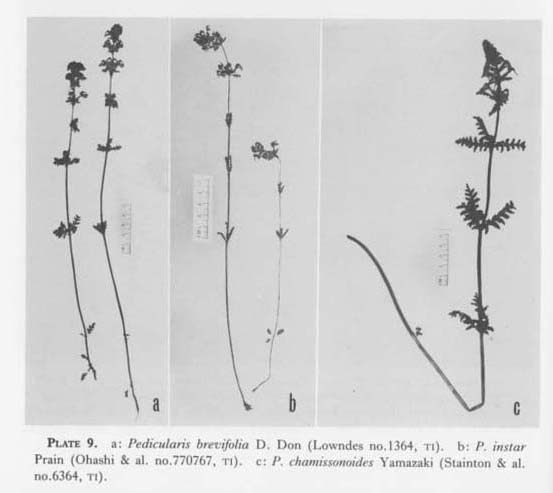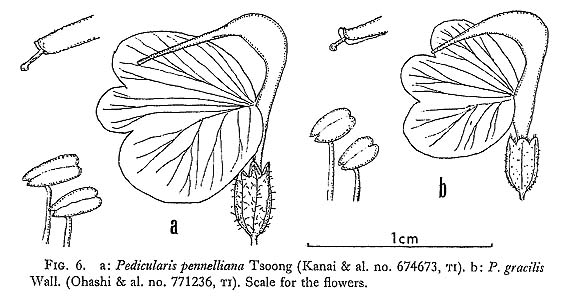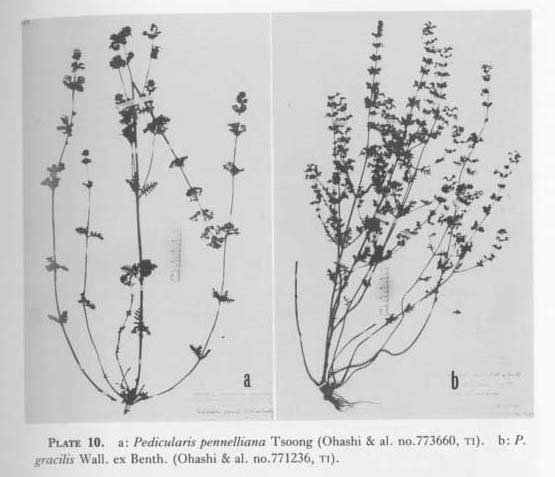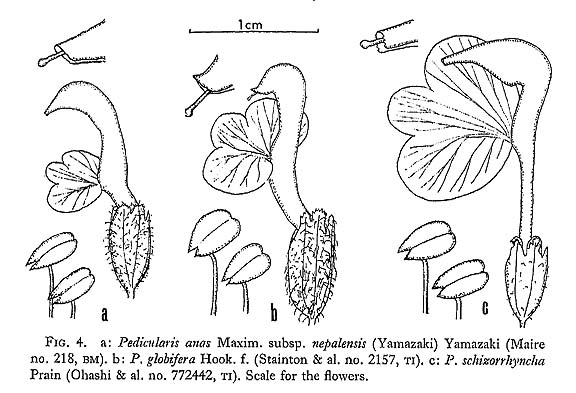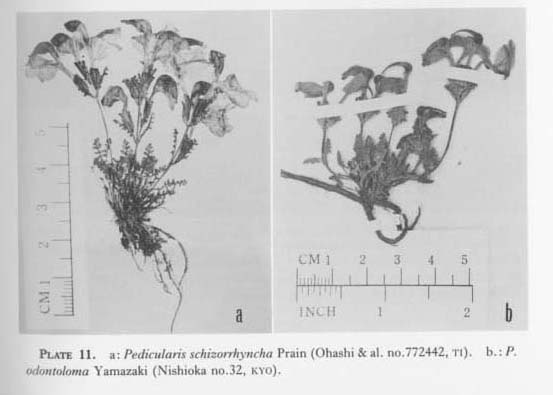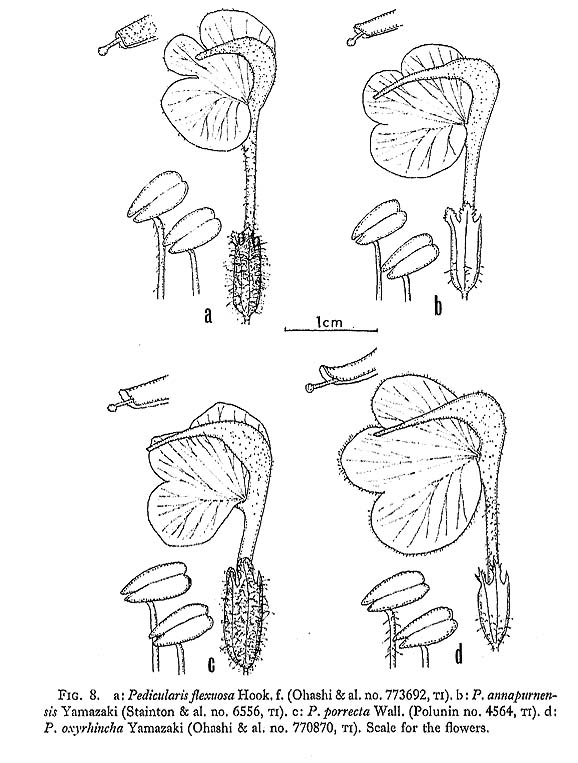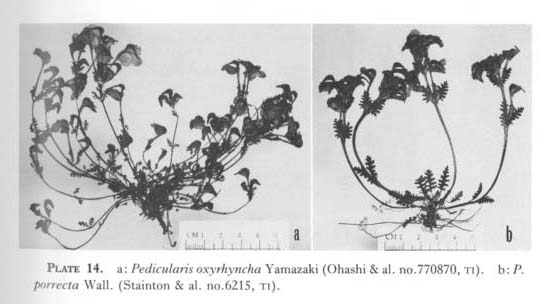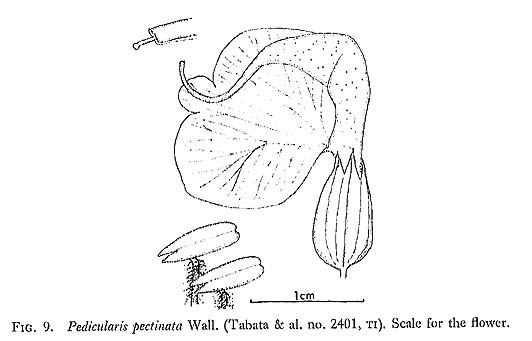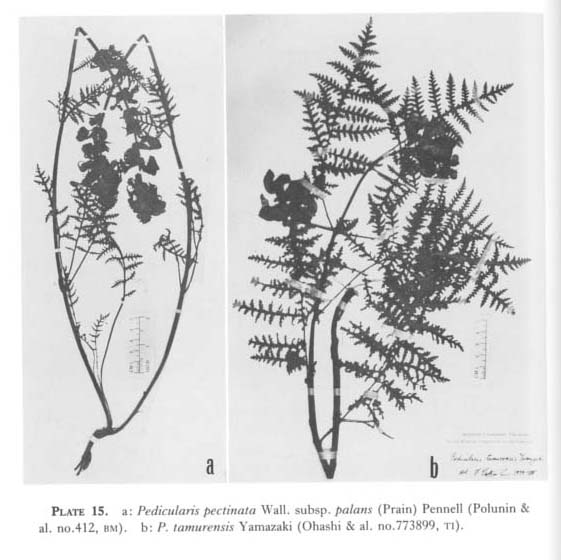A REVISION OF THE GENUS PEDICULARIS IN NEPAL
Takasi YAMAZAKI
| ( 2 / 4 ) |
Ser. 8. Graciles Maxim, in Bull. Acad. Sci. St.-Pét, 24: 52 (1877), p.p.; Prain in Ann. Bot. Gard. Calcutta 3: 72 (1890); Tsoong in Fl. Reip. Pop. Sin. 68: 77 (1963).Ser. Brevifoliae Prain in Ann. Bot. Gard. Calcutta 3: 72 (1890); Limpricht in Fedde, Rep. Sp. Nov. Veget. 20: 261 (1924); Tsoong in Fl. Reip. Pop. Sin. 68: 281 (1963). Ser. Alopecuroides Li in Proc. Acad. Nat. Sci. Philad. 100: 297 (1948). 14. Pedicularis chamissonoides Yamazaki [Plate 9c, Fig. 5a]
Yamazaki in J. Jap. Bot. 45: 148, pl. VII-8, t. 6 (1970), in Hara & al., Enum. Fl. Pl. Nepal 3: 122(1982). Perrenial (?) herbs 40-60 cm tall. Stems erect simple, glabrous below tetrafariously pubescent above. Leaves 3-verticillate; petioles 2-6 mm long; blades oblong or ovateoblong, 2-4,5 cm long 0.8-2 cm wide, glabrescent above, sparsely white-pubescent beneath, pinnatipartite, rachis winged, the pinnae 5-8-paired, oblong-lanceolate, acute at apex, doubly and acutely incised-lobate. Inflorescences in terminal spiked-racemes, with many distant faaicules having 2-3 flowers each. Bracts leaf-like smaller. Pedicels 0.5-2 mm long. Calyx tubular-urceolate, 7-9 mm long 3-4 mm, wide, lanate, 5-lobed, the posterior lobe setaceous, entire, c. 1 mm long, the lateral lobes linear, 1-3 mm long 0.5-0.8 mm wide, entire below, acute-dentate above reflexed. Corolla pink, 1.7-2 cm long, glandular-punctate under the microscope; tube straight, 8-10 mm long 1.5 mm wide, 1.3-1.5 times as long as the calyx; galea strongly decurved at the middle, the erect part 4-5 mm long, the anther-bearing part c. 2 mm wide, gradually narrowing into a slender beak, the beak c. 6 mm long, truncately acute at apex; lower lip about as long as the galea, c. 8 mm long 10 mm wide, pilose on the margins, 3-lobed, the middle lobe orbicular, c. 3 mm long and wide, the lateral lobes reniform, c. 7 mm wide. Stamens; 2 anterior filaments pilose, 2 posterior ones glabrous; anthers oblong, c. 2 mm long 1 mm wide, the cells acute at base. Distribution: C Nepal. Specimens examined: C NEPAL; Lamjung Himal, 12,500 ft, (Stainton & al. 1954, no. 6364, Holotype, BM, Isotype, TI), Janakpur zone, Ramechkap dist. Koshing Kharka-Thare Og, 4000-4100 m (Ohba & al. 1985, no. 8570659, TI). 15. Pedicularis brevifolia D. Don [Plate 9a, Fig. 5b] D. Don, Prod. Fl. Nepal. 94(1825); Benth., Scroph. Ind. 53 (1835), in DC., Prod. 10: 561 (1846); Prain in Ann. Bot. Gard. Calcutta 3: 134, t. 26A-C, f. 1-7 (1890); Limpricht in Fedde, Rep. Sp. Nov. Veget. 20: 261 (1924); Pennell in Monogr. Acad. Nat. Sci. Philad. 5: 127 (1943); Yamazaki in Hara & al., Enum. Fl. Pl. Nepal 3; 122 (1982). Annual herbs 20-40 cm tall. Root simple straight, with few rootlets. Stems erect, slender, simple, pubescent. Leaves opposite below, 3-4-verticillate upper; petioles 2-10 mm long, pilose; blades ovate, 1-2 cm long 5-13 mm wide, white-pilose on both surfaces, pinnatifid or pinnatilobed, the segments 4-6-paired, oblong or ovate-oblong, doubly acute-serrate. Inflorescences in terminal racemes, with 3-6 distant nodes having 4 flowers each. Bracts leaf-like, broadly ovate or ovate-orbicular, shorter than the calyx. Pedicels 0.5-1 mm long. Calyx tubular-campanulate, membranous, 5-7 mm long 3-4 mm wide, densely long-pilose, ventral part split about 1/3 way down, mouth 5-lobed, the posterior lobe small, setaceous, entire or dentate upper, the lateral lobes ovate or ovate-orbicular, 1.5-2.5 mm long 1-2 mm wide, irregularly acute-dentate. Corolla magenta, c. 13 mm long; tube straight, 7 mm long 1.5 mm wide, slightly longer than the calyx; galea strongly decurved at the middle, glandular-punctate under the microscope, the erect part c. 2 mm long, the anther-bearing part 2 mm wide, with obscure crest on the dorsal side, gradually narrowing into a slender beak, the beak c. 5 mm long, roundedly truncate and emarginate at apex; lower lip 8 mm long 10-12 mm wide, as long as or longer than the galea, glabrous on the margins, 3-lobed, the middle lobe broadly semi-orbicular, c. 2.5 mm long 3 mm wide, the lateral lobes broadly semiorbicular, 5-6 mm wide. Staminal filaments all glabrous. Anthers oblong, c. 1.6mm long 0.7 mm wide, the cells acute at base. Distribution: Himalayas from Hazara to C Nepal. Specimens examined: C NEPAL; Langtang, Naukunda Lekh, 3980m (G. et S. Miehe 1986, nos. 8439, 9300, TI), Jargeng Khola, 14,000 ft. (Lowndes 1950, no. 1364, BM, TI). 16. Pedicularis instar Prain ex Maxim. [Plate 9b, Fig. 5c] Maxim, in Bull. Acad. Sci. St.-Pét. 32: 547, f.32 (1888); Prain in J. As. Soc. Bengal 58: 257 (1889), in Ann. Bot. Gard. Calcutta 3: 136, t.26D, f.8-13 (1890); Limpricht in Fedde, Rep. Sp. Nov. Veget. 20: 261 (1924); Yamazaki in Hara & al., Enum. Fl. Pl. Nepal 3: 123 (1982). Annual herbs 20-50 cm tall. Root scanty, straight, with several fibrous rootlets. Stems erect, simple, crisply pubescent. Leaves distantly opposite or 4-verticillate; petioles 1-4 mm long; blades linear-oblong or lanceolate, obtuse at apex, 1-2 cm long 3-8 mm wide, sparsely white-lanate, pinnatilobed, the lobes 4-6-paired, acute-dentate reflexed. Inflorescences in terminal racemes with distant 3-6 fascicules having 4 flowers each. Bracts leaf-like small. Pedicels 1-2 mm long. Calyx urceolate-tubular, 4-5 mm long 2.5-3 mm wide, glabrescent or sparsely pilose, 5-lobed, the posterior lobe setaceous, c. 1 mm long, the lateral lobes oblong, 1-2 mm long 1 mm wide, entire below, crenate-dentate above reflexed. Corolla purple, c. 1 cm long, sparsely glandularpunctate under the microscope; tube straight, 5-6 mm long 1 mm wide, as long as or slightly longer than the calyx; galea strongly decurved at the middle, the erect part 2 mm long, the anther-bearing part 1.8 mm wide, gradually narrowing into a beak, the beak 3 mm long, truncately acute at apex; lower lip c. 5 mm long 8 mm wide, subequaling the galea, deeply 3-lobed, the middle lobe obovate, c. 4 mm long 5 mm wide, the lateral lobes obovate-orbicular, 3.5mm long 4 mm wide, glabrous on the margins. Staminal filaments all glabrous, Anthers elliptical, c. 1.2mm long 0.8 mm wide, the cella acute at base. Capsule oblong-ovate, acuminate, 8-12 mm long 4-5 mm wide. Distribution: Himalayas; E Nepal and Sikkim. Specimens examined: E NEPAL; Janakpur zone, Thare Og-Phedi Kharka, 4150 m (Ohba & al. 1985, no. 8530510, TI), Janakpur zone, Choarma-Kyama, 2600-2700 m (Ohba & al. 1985, no. 8530724, TI), Mouma-Wallunchun Gola, 3800m (Nishioka 1962, no. 1267, KYO), Lamni Nama-Tasagon, 4200m (Ohashi & al. 1977, no. 770845, TI), Topke Gola-Jalang Chhyongo (Ohba 1977, no. 772571, TI). 17. Pedicularis pennelliana Tsoong [Plate 10a, Fig. 6a]
Tsoong in Act. Phytotax. Sin. 3: 307 (1955), ut pannelliana; Yamazaki in Hara & al., Enum. Fl. Pl. Nepal 3: 124 (1982). Pedicularis gracilis Wall, var. macrocarpa Prain in Ann. Bot. Gard. Calcutta 3: 138, t.21A-C (1891). Annual herbs 10-40(-60) cm tall. Root straight simple, with several rootlets. Stems simple to many-branched, erect or ascending, bi- or quadri-fariously pubescent. Leaves opposite or 4-verticillate; lower petioles up to 1 cm long, upper ones short sometimes sessile, pubescent on the upper surfaces; blades lanceolate to lanceolate-oblong rarely ovate, 1-3 cm long 0.8-1.5 cm wide, sparsely white-pilose on both surfaces, pinnatifid, the pinnae 5-8-paired oblong pinnatilobed or incised-dentate, the lobes doubly acutedentate. Inflorescences in terminal racemes, with 3-8 lax fascicules having 2-4 flowers each. Bracts leaf-like smaller and wider. Pedicels 1-2 mm long. Calyx tubular, membranous, 5-6 mm long 2-2.5 mm wide, sparsely white-lanate, subequally 5-lobed, the lobes obovate-oblong, 1-1.5 mm long 1 mm wide, entire below acute-dentate above, reflexed. Corolla pink, with white throat, 12-14 mm long, sparsely glandular-punctate under the microscope; tube straight, 7-8 mm long 1.2 mm wide, about 1.5 times as long as the calyx; galea strongly decurved at the middle, the erect part c. 3 mm long, the anther-bearing part c. 2 mm wide, gradually narrowing into a slender beak, the beak (5-)6-7 mm long, roundly truncate and emarginate or shallowly bilobed at apex; lower lip longer than the galea, 8-10 mm long and wide, glabrous on the margins, 3-lobed, the middle lobe orbicular, c. 3 mm long and wide, the lateral lobes reniform, c. 7 mm wide. Staminal filaments all glabrous. Anthers oblong, c. 1.6 mm long 0.6 mm wide, the cells acute at base. Capsule ovate-oblong, acuminate toward the apex, 8-10 mm long 4 mm wide. Distribution: Himalayas from Bashar to Bhutan and SE Tibet. Specimens examined: W NEPAL; Gargiankot-Munigaon, SE of Jumla, 10,500 ft. (Polunin & al. 1952, no. 4816, BM, TI), Rara Lake, 2900 m (Tabata & al. 1976, no. 3035, KYO, TI), Talphi, 9,000 ft. (Polunin & al. 1952, no. 360, BM, TI). C NEPAL; Kuri Charikot, 2900 m (Kanai & al. 1970, no. 676243, TI), the same, 3100 m (Kanai & al. 1970, no. 674673, TI), Taglung, S of Tukucha, 12,000 ft. (Stainton & al. 1954, no. 7925, BM, TI), Singum Gompa-Gosainkund, 3600 m (Kanai & al. 1972, no. 721845, Ti), Tale Bisauna-Tingoang, 3000 m (Kanai & al. 1970, no. 676244, Ti), Langtang Gorge-Langtang, 3000 m (Kanai & al. 1970, no. 670477, TI), Gotiora-Gadji, 3500 m (Kanai & Malla 1969, no. 67429, TI), Tsedang Pokhari-Ponghu Danda, 3000 m (Kanai & Malla 1969, no. 674658, TI), Bitta Kharka-Patale Pokhari, 3300-4000 m (Ohba & al. 1983, no. 8351413, TI). E NEPAL; Junbesi, 86°30' E, 27°30' N, 9,500 ft. (McCosh 1964, no. 257, BM, TI), Arum-Tamur watershed, 12,500 ft. (Stainton 1956, no. 1156, BM, TI), Namche-Syangboche, 12,000 ft. (Banejii & Sakya, no. 5647, TI), Chini-Nup, Taplejung dist., 2850 m (Tabata & al. 1978, no. 11675, TI), Namche-Lamjo, 2600 m (Tabata & al. 1978, no. 10749, KYO, TI), Chhurchathanga (Ohashi & al. 1977, no. 773660, TI). 18. Pedicularis gracilis Wall. ex Benth. [Plate 10b, Fig. 6b] Benth., Scroph. Ind. 52 (1835), in DC., Prod. 10: 561 (1846); Hook, f. in Fl. Brit. Incl. 4: 307 (1884); Maxim. in Bull. Acad. Sci. St.-Pét. 32: 552 (1888), p.p.; Prain in Ann. Bot. Gard. Calcutta 3: 137, t. 19A, B; 20D, E (1891), incl. f. vera and f. stricta; Pennell in Monogr. Acad. Nat. Sci. Philad. 5: 131 (1943); Tsoong in Fl. Reip. Pop. Sin. 68: (1963); Yamazaki in Hara & al., Enum. Fl. Pl. Nepal 3: 123 (1982). Pedicularis brunoniana Wall., Cat. 14, no. 422 (1829), nom. nud. Annual herbs 30-90 cm tall. Root straight, with lax several rootlets. Stems erect, laxly many branched, bi- or quadri-fariously pubescent. Leaves opposite or 4-verticillate; petioles 5-15 mm long, pubescent on the upper surfaces; blades oblong, oblong-ovate or ovate, 1-4 cm long 0.5-2 cm wide, glabrous or sparsely white-pilose on both surfaces, pinnatifid to pinnatipartite, rachis winged, the pinnae 4-7-paired linear-oblong, acutely incised-serrate. Inflorescences in terminal slender racemes, with 4-10 lax fascicules having 2 or 4 flowers each. Bracts leaf-like smaller and wider. Pedicels 0.5-1 mm long. Calyx tubular, 3-4 mm long 2 mm wide, glabrous but sparsely glandular-punctate under the microscope, subequally 5-dentate, the teeth deltoid or broadly semi-orbicular, 0.5-0.8 mm long and wide, obtuse at apex, entire or obscurely dentate, ciliate on the margins. Corolla pink or rose, c. 10 mm long, glandular-punctate under the microscope; tube straight, 4-5 mm long 1 mm wide, slightly longer than the calyx; galea strongly decurved at the middle, the erect part c. 2 mm long, the anther-bearing part c. 2 mm wide, gradually narrowing into a slender beak, the beak 4-5 mm long, roundly truncate at apex; lower lip c. 7 mm long and wide, slightly longer than the galea, glabrous on the margins, 3-lobed, the middle lobe orbicular, c. 2.5 mm long and wide, the lateral lobes semi-orbicular, c. 5 mm wide. Staminal filaments all glabrous. Anthers elliptical, c. 1.2 mm long 0.6 mm wide, the cells acute at base. Capsule narrowly ovate or ovateoblong, acuminate at apex, 6-8 mm long 3-4 mm wide. Distribution: Himalayas from Hazara to Bhutan and S Tibet. Specimens examined: W NEPAL; Dhuli-Inuldar, Bajhang dist., 2500 m (Tabata & al, 1976, no. 1698, KYO.TI), Ranga Chauthaka, 9,000 ft. (Polunin & al. 1952, no. 435, BM, TI), Hurta -Narku, Bheri river, 7,000 ft. (Polunin & al. 1952, no. 3236, BM, TI). C NEPAL; Tukcha, 11,000 ft. (Stainton & al. 1954, no. 8140, BM, TI), near Lumaum, 7,000 ft. (Stainton & al. 1954, no. 4293, BM, TI), Panchari, 7,000 ft. (Stainton & al. 1954, no. 8944, BM, TI), near Gurjakhani, 8,500 ft, (Stainton & al. 1954, no. 3679, BM, TI), near Gustang Khola, 10,500 ft. (Stainton & al. 1954, no. 3401, BM, TI), Chandra Giri, 7,500 ft. (Bista 1966, no. 3211, TI), Marsiandy valley, 9,000 ft. (Lowndes 1950, no. 1387, BM, TI), Phulchoki, 2500m (Kanai & Chuma 1970, no. 672883, TI), Thale-Tale Bisauna, Kalingchok, 2700 m (Kanai & al. 1970, no. 672810, TI), Siklit, S of Annapurna, 84 ° 6' E, 28 ° 7' N, 3000 m (Nicolson 1976, no. 988, TI), Kyalche-Thandingma, Rolwaling Khola, 2600-3200 m (Ohba & al. 1983, no. 8351177, TI). E NEPAL; Janakpur zone, Choarma-Kyana, 2600-2700 m (Ohba & al. 1985, no. 8530724, TI), E of Jumbesi, 9,000 ft. (Schilling 1965, no. 936, TI), Chanke-Tute, 3800 m (Ohashi & al. 1977, no. 771236, TI), Hatia Gola-Digedanra, 2200 m (Ohashi & al. 1977, no. 772015, TI), Ritak-Chijung Khola, Sankhuwasabha Distr., 2500m (Tabata & al. 1978, no. 11348, KYO, TI). Sect. 5. Orthorrhynchus (Prain) Yamazaki, stat. nov., sensu emend.§§ Orthorrhynchae B. Euorthorrhynchae Prain in Ann. Bot. Gard. Calcutta 3: 72 (1890), p.p.; Limpricht in Fedde, Rep. Sp. Nov. Veget, 20: 259 (1924). Ser. 9. Pseudo-asplenifoliae Prain in Ann. Bot. Gard. Calcutta 3: 84 (1891); Tsoong in Fl. Reip. Pop. Sin. 68: 305 (1963).Ser. Pseudorostratae Limpricht in Fedde, Rep. Sp. Nov. Veget. 20: 243 (1924). 19. Pedicularis schizorrhyncha Prain [Plate 11a, Fig. 4c]
Prain in J. As. Soc. Bengal 58: 260 (1889), in Ann. Bot. Gard. Calcutta 3: 163, t. 25 C, f.13-19 (1890); Limpricht in Fedde, Rep.Rep. Sp. Nov. Veget. 20: 244 (1924); Tsoong in Act. Phytotax. Sin. 3: 322 (1955), in Fl. Reip. Pop. Sin. 68: 305, t. 67, f. 3-5 (1963); Yamazaki in Hara & al., Enum. Fl. Pl. Nepal 3: 125 (1982). Perennial herbs 4-7 cm tall. Roots several, fibrous, descending from the crown covered by withered petioles. Stems branched at base, erect, simple, pubescent. Leaves opposite, clustered at base of the stem; petioles slender, 5-15 mm long, glabrous or sparsely pilose; blades linear-oblong, 4-20 mm long 2-5 mm wide, sparsely white-pilose on both surfaces, pinnatipartite, rachis narrowly winged, the pinnae 3-8-paired, ovate or ovate-oblong, acutely incised-serrate. Flowers 1-4 above the scape, opposite or solitary. Pedicels 0.5-2 mm long. Bracts leaf-like, petioles 1-2 mm long, shorter and broader than the leaves, blades lanceolate, pinnatipartite or pinnatilobed. Calyx membranous, tubular-campanulate, 5-7 mm long 2.5-3 mm wide, ventral part split about 1/4 way down, mouth 5-lobed, the posterior lobe small setaceous, the lateral lobes oblong, acutely incised-dentate, 1-2 mm long 1 mm wide. Corolla purple, 2-2.5 cm long; tube straight, 10-12 mm long 1.5 mm wide; galea strongly arched at the middle, sparsely glandular punctate under the microscope, the erect part c. 3 mm long, the arched part 8-10 mm long 2.5-3 mm wide, auriculate on each ventral margin, gradually narrowing into a short beak, the beak c. 3 mm long 1 mm wide, truncate and dentate at apex; lower lip large, longer than the galea, c. 10 mm long 13 mm wide, glabrous on the margins, 3-lobed, the middle lobe orbicular, c. 3 mm long and wide, the lateral lobes reniform, c. 7mm wide. Staminal filaments all glabrous. Anthers elliptical, c. 1.8 mm long 1 mm wide, the cells acute at base. Distribution: Himalayas from Nepal to Bhutan and SE Tibet. Specimens examined: C NEPAL; Annapurna Himal, 15,000 ft. (Stainton & al. 1954, no. 6590, BM), Gosainkund, 4300 m (Kanai & Malla 1969, no. 15081, TI, Kanai & al. 1972, no. 72215, TI). E NEPAL; around Lamni Nama, 4200 m (Ohashi & al. 1977, no. 772442, TI). Janakpur zone, Ramechkap dist., Neju-Chub Kharka, 3600-4600 m (Ohba & al. 1985, no. 8530672, TI). Ser. 10. Remotilobae Tsoong in Fl. Reip. Pop. Sin. 68: 302 (1963).20. Pedicularis odontoloma Yamazaki [Plate 11b, Fig. 7c]
Yamazaki in J. Jap. Bot. 53: 321, f. 1 (1-2), 2 right (1978), in Hara & al., Enum. Fl. Pl. Nepal 3: 124(1982). Perennial herbs 3-6 cm tall. Roots several, thick, fleshy. Stems branched at base, simple, ascending, white-pilose. Leaves mostly radical, fasciculatc, cauline ones lacking or 1-paired, opposite; petioles 5-10 mm long, hirsute; blades oblong or oblongovate, 3-10 mm long 2-4 mm wide, hirsute on both surfaces, pinnatifid, the segments 4-6-paired, subobtusely dentate, reflexed at margins. Inflorescences in heads, with 1-2 nodes having 2 flowers each. Bracts leaf-like, with broad petioles, rhombic-obovate, 4-6 mm long 3-5 mm wide, irregularly lobed, hirsute. Pedicels 1-2 mm long. Calyx tubular, 7-8 mm long 2.5-3 mm wide, villose, 5-lobed, the posterior lobe setaceous, acuminate, c. 15 mm long, entire, the lateral lobes spathaceous, stipitate, 2-2.5 mm long 1-1.5 mm wide, entire below, acute-serrate above, reflexed at margins. Corolla probably purple, 15-18 mm long; tube straight 10-12 mm long 1.5 mm wide, about 2 times as long as the calyx; galea strongly decurved at the middle, the erect part c. 3 mm long with 2 auricles on the base of ventral margins, the anther-bearing part c. 2.5 mm wide, sparsely glandular-punctate under the microscope, gradually narrowing into a slender beak, the beak 7-8 mm long, truncately acute at apex; lower lip large, c. 10 mm long and wide, as long as or slightly longer than the galea, pilose on the margins, 3-lobed, the middle lobe broadly orbicular, incurved at apex, c. 3 mm long 4 mm wide, the lateral lobes reniform, c. 6 mm wide. Stamens; 2 anterior filaments sparsely pilose, 2 posterior ones glabrous; anthers broadly oblong, c. 1.8 mm long 0.9 mm wide, the cells acute at base. Distribution: W Nepal. Specimen examined: Tsarka, N of Mukut Himal, 4700 m (Nishioka 1958, no. 32, Holotype, KYO). Ser. 11. Debiles Prain in Ann. Bot. Gard. Calcutta 3: 72 (1890); Li in Proc. Acad. Nat. Sci. Philad. 100: 363 (1948); Tsoong in Fl. Reip. Pop. Sin. 68: 285 (1963).21. Pedicularis confertiflora Prain [Plate 12a, Fig. 7b]
Prain in J. As. Soc. Bengal 58: 258 (1889), in Ann. Bot. Gard. Calcutta 3: 142, t, 27 A-D, f. 1-8 (1890); Limpricht in Fedde, Rep. Sp. Nov. Veget. 20: 261 (1924); Tsoong in Fl. Reip. Pop. Sin. 68: 289, t.64, f. 1, 2 (1963); Yamazaki in Hara & al., Enum. Fl. Pl. Nepal 3: 122(1982). Pedicularis sectifolia Yamazaki in J. Jap. Bot. 45: 172, f.14, 19 (1982). Perennial herbs 3-23 cm tall, Roots several fibrous, descending from the short crown covered by several scales and withered petioles. Stems branched at base, simple, erect, subdensely crispy-pubescent. Leaves opposite, rarely 4-verticillate, radical ones with long petioles up to 15 mm long, cauline ones with short petioles or subsessile; blades lanceolate or oblong-lanceolate, 5-20 mm long 2-6 mm wide, sparsely white-pilose upper, white scurfy beneath, pinnatifid, the segments ovate, irregularly and doubly incised-lobed, reflexed on the margins. Inflorescences in lax spiked-racemes with 1-7 nodes having 2 or rarely 4 flowers each. Bracts leaf-like. Pedicels 1-2 mm long. Calyx tubular, 6-8 mm long 2-2.5 mm wide, villose, 5-lobed, the lobes oblong-obovate or oblong, 1.5-2 mm long 1-2 mm wide, entire below, irregularly acute-dentate above. Corolla rose, 1.5-1.8 mm long, sparsely glandular-punctate under the microscope; tube straight, 10-12 mm long 1.5mm wide; galea strongly decurved at the middle, the erect part c. 2 mm long, the anther-bearing part c. 2 mm wide, gradually narrowing into a slender beak, the beak 7-8 mm long, truncatcly acute at apex; lower lip large, c. 10mm long 12mm wide, as long as the galea, glabrous on the margins, 3-lobed, the middle lobe broadly orbicular, c. 3 mm long 4 mm wide, the lateral lobes reniform, c. 7 mm wide. Staminal filaments all glabrous. Anthers oblong, c. 1.8 mm long 0.8 mm wide, the cells acute at base. Capsule obliquely ovate, acuminate at apex, 5-7 mm long 3 mm wide, c. 1.5 times as long as the calyx. Distribution: Himalayas from C Nepal to Sikkim and SE Tibet. Specimens examined: C NEPAL; Jargen Khola, 14,500 ft. (Lowndes 1950, no. 1105, BM), Mukut, 83°26' E, 28°51' N, 15,500 ft. (Stainton 1963, no. 4439, BM), Kyangjin Gyang, 13,500 ft. (Polunin 1949, no. 1683A, BM), Khangsan-Tilicho, 4000 m (Ohba & al. 1983, no. 8310895, TI), Tilicho lake, 4800 m (Ohba & al. 1983, no. 8310917, TI), Chalike Pahar, 15,000 ft. (Stain- ton & al. 1954, no. 3699, BM, TI), Chimigaon, Kaligandaki, 14,500 ft. (Stainton & al. 1954, no. 1862, TI). E NEPAL; Topke Gola, 4300 m (Dobrcmez 1972, no, 1714, BM). 22. Pedicularis paradoxa (Prain) Yamazaki [Plate 12c, Fig. 7a] Yamazaki in J. Jap. Bot. 61: 299 (1986). Pedicularis instar Prain var. paradoxa Prain in J. As. Soc. Bengal 58: 257 (1889), in Ann. Bot. Gard. Calcutta 3: 136, t. 26E, f. 14-19 (1890); Limpricht in Fedde, Rep. Sp. Nov. Veget. 20: 201 (1924). Perennial herbs 5-10 cm tall. Roots several, fleshy, elongate-fusiform, descending from the crown covered by several scales and withered petioles. Stems branched at base, erect simple, subdensely pilose. Leaves opposite, mostly radical, cauline ones 1-2-paired; petioles of radical leaves 5-10 mm long, of cauline ones 0.5-2 mm long, long-pilose; blades linear or linear-oblong, obtuse at apex, 3-8 mm long 1-3 mm wide, villose on both surfaces, pinnatifid, the segments 4-7-paired acute-dentate reflexed. Inflorescences in terminal racemes, with 1-3 fascicules having 2 flowers each. Bracts leaf-like small. Pedicels 2-6 mm long. Calyx tubular-campanulate, 4-5 mm long 1.5- 2.5 mm wide, villose, 5-lobed, the posterior lobe small setaceous, the lateral lobes oblong or obovate-oblong, 1-1.5 mm long 0.5-1 mm wide acute-serrate reflexed. Corolla reddish purple, 12-13 mm long, sparsely glandular-punctate under the microscope; tube straight, 6-7 mm long, 1.2-1.5 times as long as the calyx; galea strongly decurvedat the middle, the erect part c. 2.5 mm long, the anther-bearing part c. 2 mm wide, gradually narrowing into a slender beak, the beak 4-5 mm long, truncately acute and emarginate at apex; lower lip c. 8 mm long 10 mm wide, subequaling the galea, glabrous on the margins, deeply 3-lobed, the middle lobe orbicular-obovate, c. 6 mm long 5 mm wide, the lateral lobes reniform, c. 5 mm long and wide. Staminal filaments all glabrous. Anthers elliptical, c. 1.4 mm long 0.9 mm wide, the cells acute at base. Distribution: Himalayas; E Nepal and Sikkim. Specimen examined: E NEPAL; around Lamni Nama, 4300-4400 m (Ohashi & al. 1977, nos. 770798, 775106, TI). 23. Pedicularis heydei Prain [Plate 12b, Fig. 7e] Prain in J. As. Soc. Bengal 58: 258, t. 2 (1889), in Ann. Bot. Gard. Calcutta 3: 140, t.27E, f. 9-14 (1891); Pennell in Monogr. Acad. Nat. Sci. Philad. 5: 126 (1943); Yamazaki in Hara & al., Enum. Fl. Pl. Nepal 3: 123 (1982), in J. Jap. Bot. 61: 300 (1986). Perennial herbs 3-8 cm tall. Roots several, fleshy, elongate-fusiform, descending from the crown covered by withered petioles. Stems branched at base, erect, simple, with subdense crispy pubescent hairs. Leaves opposite; radical ones with petioles 4-10 mm long, blades linear or linear-oblong, 4-12 mm long 1-3 mm wide, pubescent on both surfaces, regularly pinnatifid to pinnatilobed, the segments 6-10-paired, ovate or ovateoblong, obtuse at apex, entire or few dentate; cauline leaves 1-2-paired, petioles short and broad. Inflorescences in heads with 2-3 nodes having 2 flowers each. Bracts ovate to broadly ovate, as long as or shorter than the calyx, entire below, deeply lobed above, the lobes obtuse at apex. Pedicels 0.5-1 mm long. Calyx tubular-campanulate, 4-6 mm long 2.5 mm wide, villose, 5-lobed, the posterior lobe narrowly triangular, subacute, c. 1 mm long, the lateral lobes oblong, obtuse at apex crenate-serrate, 1.5-2 mm long 1 mm wide. Corolla dark red, c. 10 mm long, glabrous; tube straight, 6-7 mm long 1 mm wide, as long as or longer than the calyx; galea strongly decurved at the middle, the erect part c. 2 mm long, the anther-bearing part c. 2 mm wide, gradually narrowing into a slender beak, the beak c. 5 mm long, truncately acute at apex; lower lip c. 6 mm long 8 mm wide, as long as the galea, glabrous on the margins, 3-lobed, the middle lobe orbicular c. 2.5 mm long and wide, the lateral lobes broadly semi-orbicular, 3-4 mm wide. Staminal filaments all glabrous. Anthers elliptical, c. 1.2 mm long 0.7 wide, the cells apiculate at base. Capsule oblong-lanceolate, acuminate, c. 7 mm long 2.5 mm wide. Distribution: Himalayas from Kashmir to E Nepal and S Tibet. Specimens examined: W NEPAL; Saipal (Arnold 1954, no. 90, BM). C NEPAL; Jargeng Khioa, 15,500 ft. (Lowndes 1950, no. 1350, BM), Phedi-Thanti, 4000-4400 m (Ohba & al. 1983, no. 833097, TI), E NEPAL; Yangma, Taplejung dist., 4000 m (Tabata & al, 1978, no. 11847, KYO, TI). 24. Pedicularis poluninii Tsoong [Plate 12d, Fig. 7d] Tsoong in Act. Phytotax. Sin. 3: 290, 323, t.40 (1955), in Bull. Brit. Mus. (Nat. Hist.) Bot. 2: 15 (1955); Yamazaki in Hara & al., Enum. Fl. Pl. Nepal 3: 124 (1982). Perennial herbs 5-25 cm tall, with slender rhizomes, Root simple fleshy. Stems ascending or diffused, many-branched at base, branches simple, pubescent. Leaves opposite or 4-verticillate; petioles 2-5 mm long, pilose; blades ovate or oblong, 4-10 mm long 2-5 mm wide, sparsely white-pilose on both surfaces, pinnatisect, rachis narrowly winged, the pinnae 2-4-paired, oblong, doubly acute-serrate. Inflorescences in terminal racemes, with distant 2-7 fascicules having 2-4 flowers each. Bracts leaf-like, shortly petiolate. Pedicels 0.5-2 mm long. Calyx tubular 5 mm long 2 mm wide, villose, 5-lobed, the posterior lobe setaceous, acute, entire, the lateral lobes oblong-lanceolate, 1-2 mm long 0.5 mm wide, entire below dentate above, the teeth acute reflexed. Corolla rose, c. 13 mm long, subdensely glandular-punctate under the microscope; tube straight, 7 mm long 1 mm wide, 1.5-2 times as long as the calyx; galea strongly decurved at the middle, the erect part c. 2 mm long, the anther-bearing part c. 2 mm wide, gradually narrowing into a slender beak, the beak c. 3 mm long, roundly trun cate and emarginate at apex; lower lip as long as the galea, c. 6 mm long 9 mm wide, glabrous on the margins, 3-lobed, the middle lobe broadly orbicular, c. 3 mm long 4 mm wide, the lateral lobes orbicular-ovate, c. 4 mm wide. Staminal filaments all glabrous. Anthers oblong, c. 1.4 mm long 0.7 mm wide, the cells acute at base. Capsule oblong-lanceolate, c. 10 mm long 4 mm wide, c. 1.5 times as long as the calyx. Distribution: C Nepal and S Tibet. Specimens examined: C NEPAL; Lari, 85° E, 28° N, 4500 m (Lyon 1974, no. 357, BM), Ja-nakpur zone, Ramechkap dist., Thare Og-Bigphera Lho Glacier, 4200-4700 m (Wakabaya-shi & al., 1985, no. 8570861, TI). E NEPAL; Sagarmatha zone, Soluhkumbu dist., Dudh Kin-id -Beni Kharka, 4000-4500 m (Wakabayashi & al., 1985, no. 857271, TI). Sect. 6. Astenocaulus (Tsoong) Yaniazaki, stat. nov.Grex Cyclocladus subgrex Astenocaulus Tsoong in Fl. Reip. Pop. Sin, 68: 85 (1963). Ser. 12. Flexuosae Prain in Ann. Bot. Gard. Calcutta 3: 73 (1890), p.p.; Tsoong in Fl. Reip. Pop. Sin. 68: 85 (1963).25. Pedicularis flexuosa Hook. f. [Plate 13b, Fig. 8a]
Hook. f. in Fl. Brit. Ind. 4: 308 (1884); Maxim. in Bull. Acad. Sci. St.-Pét. 32: 551, f.35 (1888); Prain in Ann. Bot. Gard. Calcutta 3: 143, t. l8A, B, f. 1-8 (1890); Lim-pricht in Fedde, Rep. Sp. Nov. Veget. 20: 258 (1924); Tsoong in Fl. Reip. Pop. Sin. 68: 85 (1963); Yamazaki in Hara & al., Enum. Fl. Pl. Nepal 3: 123 (1982). Perennial herbs 10-40 cm tall. Roots many, fibrous, decending from the woody crown. Stems many-branched at base, simple slender, glabrous below shortly pubescent above. Leaves opposite; the radical ones with pilose long petioles up to 12 cm long, blades lanceolate to linear-oblong, 2-9 cm long 1-3 cm wide, sparsely pilose on both surfaces, pinnatipartite, rachis winged, the pinnae 5-8-paired, lanceolate or linear-oblong, pin-natilobed, the lobes acute at apex, acute-serrate; the cauline leaves with short petioles 0,5-3 cm long, blades oblong-ovate or ovate, 1-4 cm long 0.6-2 cm wide, pinnatifid. Flowers solitary-axillary lower and in terminal lax leafy spiked-racemes upper. Pedicels 1-2 mm long, pilose. Calyx tubular, 10 mm long 2.5 mm wide, with dense long pilose hairs, 5-lobed, the posterior lobes setaceous, acute, entire, c. 2 mm long 0.6mm wide, the lateral lobes oblong-obovate irregularly acute-dentate, 2-3 mm long 1.5 mm wide. Corolla pink or rose-purple, 2.5-5 cm long; tube straight, 2-4.5 cm long 1.5 mm wide, 2-4 times as long as the calyx, pilose; galea strongly decurved at the middle, the erect part 3-4 mm long, the anther-bearing part 2-2.5 mm wide, subdensely glandular-punctate under the microscope, gradually narrowing into a beak, the beak 4-6 mm long truncate at apex; lower lip large, longer than the galea, 10-12 mm long 12-14 mm wide, glabrous or sparsely pilose on the margins, 3-lobed, the middle lobes orbicular 4-5 mm long and wide, the lateral lobes reniform, 8-1 mm wide. Stamens; 2 anterior filaments sparsely pilose, 2 posterior ones glabrous. Anthers oblong, c. 1.8 mm long 0.9 mm wide, the cells obtuse at base. Capsule oblong-lanceolate, acuminate toward the apex, 10-14 mm long 3-4 mm wide. Distribution: Himalayas from C Nepal to Bhutan and SE Tibet. Specimens examined: C NEPAL; Tsedang Pokhari-Panghu Danda, 3000 m (Kanai & Malla 1969, no. 674658, TI), Talc Bisauna-Tingoang, 3000 m (Kanai & al, 1970, no. 672837, TI), Oo Kharka-Mul Kharka, Langtang, 3400-3800 m (Kanai & Shakya 1970, no. 672192, TI). E NEPAL; Lumding Khola, 86°30' E, 27°30' N, 10,000 ft. (McCosh 1964, no. 402, BM, TI), Janakpur zone, Dubikharka-Baula Pokhari, 3700-4000 m (Ohba & al. 1985, no. 8580219, TI), Janakpur zone, Thare Og-Phedi Kharka, 4100m (Ohba & al. 1985, no. 8530514, TI), Chhurchathanga-Thudam, 3800 m (Ohashi & al. 1977, no. 773692, TI), Thudam, 3800 m (Kanai & al. 1972, no. 720600, TI), Thudam-Lamni Nama (Ohashi & al. 1977, no. 775043, TI), Simbua Khola, 87°57' E, 27°32' N, 12,500 ft, (Williams 1969, no. 842, BM, TI), Topke Gola-Shewaden, 3380 m (Kanai & al, 1972, no. 721786, TI), Thudam-Lamni Nama, 3400 m (Ohashi & al. 1977, no. 773726, TI), Jongbuh-Thudam, 3550 m (Tabata & al. 1978, no. 11427, KYO, TI). 26. Pedicularis annapurnensis Yamazaki [Plate 13a, Fig. 8b] Yamazaki in J. Jap. Bot, 45: 146, f. 4, pl. VIII-7 (1970), in Hara & al., Enum, Fl. Pl. Nepal 3: 122(1982). Perennial herbs 25-40 cm tall. Roots fibrous, descending from woody crown. Stems branched at base, simple, slender, ascending, bifariously pilose. Leaves opposite; radical ones with long petioles up to 12 cm long, pilose on the margins, blades linear-oblong, 3-5 cm long 1-2 cm wide, glabrescent on both surfaces, pubescent on the main nerves above, pinnatifid, the segments oblong-ovate pinnately lobed, the lobes acute-serrate; cauline leaves with short petioles 0.5-2 cm long, blades ovate-oblong to ovate, 1,5-3 cm long 1-1.5 cm wide, pinnatifid. Flowers solitary-axillary and in, lax leafy racemes, with 2-4 nodes having two flowers each. Pedicels 13 mm long. Calyx tubular, 7-8 mm long 1-2.5 mm wide, sparsely pilose on the lower-half, 5-lobed, the posterior lobe setaceous, acute, c, 0.5 mm long, the lateral lobes obovate, irregularly acute-dentate, c, 2 mm long 1.5-2 mm wide. Corolla dark red, 2.5 cm long; tube straight, 15 mm long 1 mm wide, about 2 times as long as the calyx; galea strongly decurved at the middle, the erect part c. 4 mm long, the anther-bearing part 2,5 mm wide, sparsely glandular-punctate under the microscope, gradually narrowing into a slender beak, the beak, c. 6 mm long, truncately acute at apex; lower lip large, c. 10 mm long 13 mm wide, subequaling the galea, glabrous on the margins, 3-lobed, the middle lobe broadly orbicular, c. 5 mm long 7 mm wide, the lateral lobes reniform, c. 8 mm wide. Staminal filaments all glabrous. Anthers oblong, c. 1.8 mm long 0,9 mm wide, the cells obtuse at base. Distribution: C Nepal. Specimens examined; Seti Khola, Annapurna Himal. (Stainton & al, 1954, no, 6556, Holotype BM, Isotype TI). 27. Pedicularis porrecta Wall. ex Benth. [Plate 14b, Fig. 8c]
Benth., Scroph. Ind. 52 (1835), in DC., Prodr. 10: 561 (1846); Hook. f. in Fl. Brit. Ind. 4: 307 (1884); Maxim, in Bull, Acad. Sci. St.-Pét. 32: 550 (1888), p.p.; Pram in Ann. Bot. Gard. Calcutta 3: 141, t.20A-C, f. 1-10 (1890); Limpricht in Fedde, Rep. Sp. Nov. Veget. 20: 260 (1924); Pennell in Monogr. Acad. Nat. Sci. Philad. 5: 128 (1943); Yamazaki in Hara & al., Enum. Fl. Pl. Nepal 3: 124 (1982), Perennial herbs 5-18 cm tall. Roots several fleshy, descending from short crown cov ered by scales and withered petioles. Stems branched at base, simple, stout, erect or ascending, with bifarious crispy long pilose hairs. Leaves opposite, radical ones clustered and long-petioled up to 2 cm long, cauline ones 1-2-paired shortly petioled, petioles with dense villose hairs on the upper surfaces; blades linear-oblong to ovate-oblong, 0.8-3 cm long 4-10 mm wide, glabrous or sparsely white-pilose on both surfaces, pinnatifid, the pinnae 4-8-paired, oblong or oblong-ovate, acute-serrate, reflexed on the margins. Inflorescences in lax spiked racemes or heads, with 2-4 nodes having 2 flowers each. Bracts leaf-like, broadly ovate, with short broad petioles, as long as the calyx. Pedicels 1-3 mm long. Calyx tubular, 8-9 mm long 2.5 mm wide, villose, 5-lobed, the posterior lobe setaceous, acuminate at apex, entire, c, 1 mm long, the lateral lobes obovate, irregularly crenate-dentate, reflexed, 1-2 mm long and wide. Corolla reddish purple, 2-2.5 cm long, sparsely glandular-punctate under the microscope; tube straight, 10-15 mm long 1 mm wide, about 2 times as long as the calyx; galea strongly decurved at the middle, the erect part c. 2 mm long, the anther-bearing part 2.5-3 mm wide, gradually narrowing into a slender beak, the beak, c. 6 mm long, obliquely truncate at apex; lower lip large, subequaling the galea, c. 10 mm long 12 mm wide, 3-lobed, the middle lobe orbicular, c. 4 mm long 5 mm wide, the lateral lobes reniform, c, 7 mm wide, glabrous on the margins. Staminal filaments all glabrous. Anthers oblong c. 2 mm long 1 mm wide, the cells obtuse at base. Distribution: Himalayas from Chamba to C Nepal and S Tibet. Specimens examined: W NEPAL; Rara-Chuchemara pass, Mugu dist., 3800 m (Tabata & al. 1983, no. 16790, KYo), Bhurchula Lackh, near Jumla, 13,000 ft. (Polunin & al. 1952, no. 4564, BM, TI), the same, 12,000 ft. (Polunin & al. 1952, no. 4608, BM, TI), Lari 85°0' E, 28°4' N, 4400 m (Lyon 1974, no. 132, no. 254, TI). C NEPAL; Rambrong, Lamjung Himal, 14,500 ft. (Stainton & al. 1954, no. 6215, BM, TI), Khangsar, 15,000 ft. (Lowndcs 1950, no. 1272, BM), Gadje-Surja Kund, 3900-4400 m (Malla & Kanai 1969, no, 15080, TI). 28. Pedicularis oxyrhyncha Yamazaki [Plate 14a, Fig. 8d] Yamazaki in J. Jap. Bot. 61: 297, f. 1, 2a (1986). Annual (?) herbs 5-23 cm tall. Root straight, simple or with several rootlets. Stems many-branched at base, slender, simple, ascending, glabrous below, bifariously shortpubescent upper. Leaves opposite, mostly cauline; petioles slender, 2-25 mm long, glabrous or sparsely pilose on the margins; blades membranous, linear-oblong, 3-15 mm long 1.5-7 mm wide, sparsely white-pilose on both surfaces, pinnatipartite, rachis winged, the pinnae 4-6-paired, oblong or oblong-ovate, acute at apex, acuminate-serrate. Flowers solitary-axillary or in short racemes, with 1-4 nodes having 2 flowers each. Bracts leaf-like, ovate, with broad petioles, as long as or shorter than the calyx, sparsely long-pilose. Pedicels slender, 2-10 mm long, glabrous. Calyx membranous, tubular, 5-7 mm long 1.5-2 mm wide, sparsely to subdensely villose, 5-lobed, the posterior lobe setaceous acuminate at apex entire 1 mm long, the lateral lobes oblong or oblong-ovate, entire below, acuminate-dentate above, 1.5-2 mm. long 1 mm wide. Corolla purple, 1.5-3 cm long, sparsely glandular-punctate under the microscope; tube straight, 10-23 mm long 1 mm wide, 2-3 times as long as the calyx, sparsely pilose or glabrous; galea strongly decurved at the middle, the erect part c. 2 mm long, sometimes with a process on each ventral margin, the anther-bearing part 2-2,5 mm wide, gradually narrowing into a slender beak, the beak c. 6 mm long, obliquely acute at apex; lower lip large, c. 12 mm long 14 mm wide, as long as or slightly longer than the galea, pilose on the margins, 3-lobed, the middle lobe orbicular 5-6 mm long and wide, the lateral lobes broadly semi-orbicular, c. 7 mm wide. Staminal filaments all glabrous. Anthers oblong, c. 2 mm long 1 mm wide, the cells obtuse at base. Capsule obliquely ellipsoid, acuminate at apex, 8-9 mm long 4 mm wide. Distribution: Himalayas; C and E Nepal. Specimens examined: C NEPAL; Ganja La, 85°35' E, 28°10' N, 15,000 ft. (Stainton 1962, no. 4116, BM, TI). E NEPAL, Tasagon-Topke Gola, 4100 m (Ohashi & al. 1977, no. 770870, Type, TI), Lamni Nama-Tasagon, 4400 m (Ohashi & al. 1977, no. 770849, TI), Thudam- Lamni Nama, 4000 m (Ohashi & al. 1977, no. 770768, TI), Topke Gola-Jnlang Chhyongo, 3900 m (Ohaahi & al. 1977, no, 772567, TI). Ser. 13. Pectinatae Pram in Ann. Bot. Gard. Calcutta 3: 71 (1891), p.p.; Li in Proc. Acad. Nat Sci. Philad. 100: 285 (1848); Tsoong in Fl. Reip, Pop. Sin. 68: 224 (1963).29. Pedicularis pectinata Wall. ex Benth. aubsp, palans (Prain) Pennell [Plate 15a, Fig. 9]
Pennell in Monogr. Acad. Nat. Sci. Philad. 5: 132 (1943). Pedicularis pectinata Wall. var. palans Prain in Ann. Bot. Gard. Calcutta 3: 130, t.23B, C (1891); Limpricht in Fedde, Rep. Sp. Nov. Veget. 20: 262 (1924). Perennial herbs 40-60 cm tall. Root thick woody. Stems branched at base, stout simple, erect, glabrous. Leaves opposite or 3-verticillate; petioles 1-15 cm long, glabrous; blades lanceolate or linear-oblong, 3-12 cm long 1-4 cm wide, glabrous, pinnatisect, rachis narrowly winged, the pinnae lanceolate or linear-oblong acute at apex pinnately lobed, the lobes acute at apex, acute-serrate. Inflorescences in terminal spiciform, with 6-8 nodes having 2-3 flowers each, the rachis bifariously lanate. Bracts broadly lanceolate to lanceolate, attenuate-acuminate at apex, as long as or longer than the calyx, 6-15 cm long 3 cm wide. Pedicels 0.5-1 mm long. Calyx membranous, urceolate-tubular, c. 10 mm long 3-4 mm wide, glabrous, with 10 prominent nerves, 5-lobed, the posterior lobe linear acuminate entire, the lateral lobes linear, lanceolate or oblong-lanceolate aristate-acuminate at apex, 2-3 mm long 1-1.5 mm wide, obscurely denticulate or entire. Corolla reddish violet, 2-2.5 cm long; tube straight, 10-13 mm long 1.5 mm wide, 1-1.5 times as long as the calyx; galea strongly decurvcd at the middle, the erect part 4-5 mm long, the anther-bearing part 3-4 mm wide, gradually narrowing into a slender beak, the beak c. 12 mm long twisted, truncately acute at apex; lower lip large, c. 12 mm long 15 mm wide, glabrous on the margins, 3-lobed, the middle lobe small orbicular c. 2.5 mm long 3 mm wide, the lateral lobes reniform c. 10 mm wide. Staminal filaments all densely villose. Anthers linear-oblong, c. 3 mm long 1.2 mm wide, the cell subacute at base. Distribution: Himalayas from Rawalpindi to W Nepal. Specimens examined: W NEPAL; Godilekh, Bajhang dist., 3000 m (Tabata & al. 1976, no. 2401, KYO, TI), Ripa Humla dist., 3000 m (Tabata & al. 1983, no. 24163, KYO), Chute Gaon-Chuteko Lekh, Mugu dist., 3950 m (Tabata & al. 1983, no. 17976, KYO), Ratanaata, Chnkure Lagma, 12,500 ft. (Polunin & al. 1952, no. 412, BM). Note. The Nepal specimens slightly differ from the type the subsp. palans by the calyx glabrous and the sepals aristate-acuminate. Sect. 7. Elephanticeps Yamazaki, sect. nov.Caulis rigidus erectus. Folia plerumque caulina, opposita. Inflorescentia terminalis spicato-racemosa, floribus oppositis. Galea corollarum rostrata; labium inferum amplissimum. Typus: Pedicularis integrifolia Pram. Ser. 14, Integrifoliae Prain in Ann. Bot. Gard. Calcutta 3: 70 (1890); Li in Proc. Nat. Sci. Philad. 100: 351 (1948); Tsoong in Fl. Reip. Pop. Sin. 68: 296 (1963).30. Pedicularis integrifolia Hook. f. [Plate 12e, Fig. 10b]
Hook. f. in Fl. Brit. Ind. 4: 308 (1884); Maxim. in Bull, Acad. Sci. St.-Pét. 32: 545, t. 23 (1888); Prain in Ann. Bot. Gard. Calcutta 3:128, t. 5D, f. 22-27 (1890); Limpricht in Fedde, Rep. Sp. Nov, Veget. 20: 264 (1924); Tsoong in Fl. Reip. Pop. Sin. 68; 296 (1963); Yamazaki in Hara & al., Enum. Fl. Pl. Nepal 3: 123 (1982). Perennial herbs. Root thick, fleshy, straight, sparsely branched, crown covered by withered petioles and scales. Stems branched at base, simple, ascending, 5-13 cm long, hirsute. Leaves opposite; radical ones clustered, petioles 5-13 mm long, hirsute on the upper surfaces, blades chartaceous, linear-lanceolate acute at apex, attenuate into the petioles at base, 1-3 cm long 4-8 mm wide, scabrous on both surfaces, crenate-dentate, reflexed on the margins; cauline leaves 2-3-paired, sessile, narrowly oblong, 10-15 mm long 7-10 mm wide, crenate-dentate. Flowers in terminal spikes, with 1-2 nodes having 2 flowers each, subsessile. Bracts broadly ovate or orbicular-ovate, broadly short-petioled, as long as or shorter than the calyx, obtuse at apex, crenate-dentate. Calyx tubular, 12-15 mm long 4 mm wide, densely hirsute, 5-lobed, the posterior lobe ovate, c. 2 mm long 1.5 mm wide, entire, the lateral lobes linear-oblong or lanceolate, obtuse at apex, c. 4 mm long 1,5-2 mm wide, entire or shallowly crenate-dentate. Corolla purple, c. 3 cm long, sparsely glandular-punctate under the microscope; tube straight, 2 cm long 1.5 mm wide, about 2 times as long as the calyx; galea strongly decurved at the middle, the erect part c, 3 mm long, the anther-bearing part c, 5 mm wide, slightly inflated at the ventral side, suddenly narrowing into a slender beak, the beak c. 15 mm long twisted, truncately acute at apex; lower lip c. 10 mm long 15 mm wide, shorter than the galea, glabrous on the margins, 3-lobed, the middle lobe orbicular, 5 mm long and wide, the lateral lobes rhomboid, c. 7 mm wide. Staminal filaments all villose. Anthers oblong, c. 3 mm long 1.5 mm wide, the cells obtuse at base. Distribution: Himalayas from C Nepal to Sikkim and SE Tibet. Specimens examined: C NEPAL; Dolpo, Chharke, 83°26' E, 29°0' N, 16,000 ft. (Stainton 1966, no, 5564, BM, TI). Sect. 8, Cryptorhynchus Yamazaki, sect nov.Caulis rigidus erectus. Folia plerumque caulina opposita. Inflorescentia terminalis spicato-racemosa, floribus oppositia. Galea rostrata; labium inferum amplissimum. Typus: Pedicularis ludlowiana Tsoong. Ser. 15. Ludlowianae Tsoong in Act. Phytotax. Sin. 3: 288 (1954).31. Pedicularis tamurensis Yamazaki [Plate 15b, Fig. 10a] Yamazaki in J. Jap. Bot. 45: 174, t. 16, 20 (1970), in Hara & al., Enum. Fl, Pl. Nepal 3: 125(1982). Perennial herbs 40-100 cm tall. Rhizome woody shortly prostrate, with many fleshy thick roots. Stems stout simple erect, hirsute. Leaves opposite, membranous; petioles 2.5-11 cm long, with patent long brownish ciliate hairs; blades oblong or ovate-oblong, 10-30 cm long 5-12 cm wide, pinnatisect, rachis winged with long brownish ciliate hairs, the pinnae 6-10-paired lanceolate, acute at apex, pinnatifid, sparsely long-pilose, the lobes lanceolate, acute at apex, acutely and doubly incised-lobate. Inflorescences in terminal spiked racemes, with many alternate flowers, 5-15 cm long 1 cm wide. Bracts oblong-ovate or ovate, as long as or longer than the calyx, petioles broad, covering the calyx, long-ciliate, blades small pinnately lobed. Pedicels 1-3 mm long. Calyx membranous, campanulate, 10-13 mm long 7 mm wide, with long white ciliate hairs, ventral part split about 1/2 way down, mouth irregularly 5-lobed, the posterior lobe obovate, c. 4 mm long and wide, deeply bilobed and doubly acute-serrate, the lateral lobes broadly ovate or orbicular, c. 5 mm long 4-7 mm wide, deeply 2-3-lobed and irregularly and doubly acute-serrate. Corolla white or pale pink c. 3 cm long, glabrous but sparsely glandular-punctate under the microscope; tube 5 mm long 2 mm wide, included in the calyx; galea strongly decurved at the middle, the erect part c. 2 mm long, the anther bearing part c. 4 mm wide, gradually narrowing into a slender beak, the beak c. 12 mm long bilobed at apex; lower lip very large, covering the galea, c. 16 mm long 30 mm wide, pilose on the margins, 3-lobed, the middle lobe broadly orbicular, c, 9 mm long 11 mm wide, 2 lateral lobes orbicular, c. 13 mm wide. Staminal filaments all glabrous. Anthers oblong, c. 2.8 mm long 1.8 mm wide, the cells obtuse at base. Distribution: E Nepal. Specimens examined: E Nepal; Tamur valley, Mew Khola, 11,000 ft. (Stainton 1956, no. 1313, Type, BM), Topke Gola-Shewaden, 2800 m (Ohashi & al. 1977, no. 773899, TI), the same, 2900 m (Ohashi & al, 1977, no. 772690, TI). |

